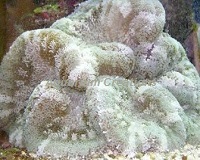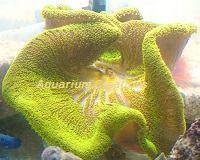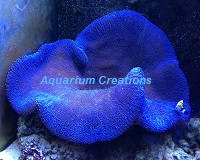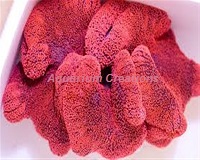
|
|
|
|
|
|
|
|
|
|
Saddle Carpet Anemone For Sale
Blue Saddle Carpet, Red Saddle Carpet, Green Saddle Carpet
| The saddle carpet anemone, (Stichodactyla Haddoni) is also called the Haddon's Carpet Anemone, also called Haddoni Carpet, Saddle Anemone, or Saddleback Anemone. Saddle Carpet Anemone live singly, in the shallow waters of the Central Pacific, Indo Pacific, and the Red Sea. The shallow waters give the saddle carpets such bright colors. They have very small tentacles typically looking like little beads covering the surface. They can grow to about 2-1/2 feet in diameter and have a relatively large base. A small area around the mouth is free of tentacles. The saddle carpet can be distinguished from their close relatives Stichodactyla gigantea and Stichodactyla mertensii by the lack of any spots or markings on the underside of the anemone and down its column. Interesting to note why this carpet is called a Saddle Carpet. This is because the large upper part of the anemone, the disc, is frequently folded into what looks like a saddle, hence the name Saddle Carpet Anemone. |
| Assorted Saddle Carpet, Stichodactyla Haddoni starting at $99.99 |
Green Saddle Carpet, Stichodactyla Haddoni starting at $219.99 |
Blue Saddle Carpet, Stichodactyla Haddoni starting at $799.99 |
Red Saddle Carpet, Stichodactyla Haddoni starting at $1099.99 |
|---|---|---|---|
 |
 |
 |

|
|
Tank Recommendations: A 125 gallon or larger aquarium is highly recommended, and preferably one that has been running six months at the bare minimum. Carpet anemone need a large, stable, and established marine aquarium. Water parameters and temperature should remain rock steady at all times in order for long term success to be had. Lighting Requirements: Although the blue spectrum is useful to pull out the beautiful colors, it is useless from a photosynthetic perspective. Carpet anemones house symbiotic algae (zooxanthellae) in their tissues, just like reef-dwelling corals do, and thus rely heavily on strong lighting in order to stay healthy. They don’t necessarily require a full-blown reef-lighting system with metal halide bulbs, but they do need at least a few high-output T5 flourescent bulbs over a small or medium system and add a few more t5's if its a larger aquarium. Lighting in the 5,500-10,000 kelvin temperature range is highly recommended for at least a portion of the day. Water Flow: Correct water flow is important for the anemone's long term success. Carpet anemone like random, turbulent water flow that is strong enough volume to lightly 'ruffle' the edges of the anemone. Stronger flow (especially laminar) would more than likely be to excessive and harm the anemone. Care must be taken with powerheads in saltwater aquariums containing anemones, as the anemone will be killed if caught by the pumps intake. Care also needs to be taken around overflows and similar areas should have their intakes covered with a sponge to prevent damaging the anemone if it went for a walk around the aquarium. Anemone Placement: The gigantea carpet anemone is typically found attached to something solid that’s buried in the sand such as a rock, or the bottom of the tank. Once in a while you may find one attached to hard substrates at the surface. I always suggest with carpet anemones, after lowering the water flow, dig a hole in the sand and place the base of the anemone in the hole. Next, place some sandy substrate around the column and increase the flow rate back to the normal output. Doing this will allow the anemone time to settle in and bury its foot completely into the sand bed. Finally place a piece of live rock directly next to it. Food and diet: Carpet anemone are carnivores, and a good meaty diet once or twice a week is all they ever should need. Experiment with different meaty foods to find out what and how much they’ll eat. Carpet anemone should be fed raw, minced meaty seafood items (shrimp, shellfish, fish, and krill to name a few, attained from your local grocery store), chopped to about 1/4 inches in size. Anemone do not have the capacity to "think" and will grab and attempt to ingest any meaty item that is fed to them, but do not mistake this as a reason to feed large pieces or whole animals (shrimp, fish), which will usually be regurgitated later and can possibly injure the animal internally. Level of Care: Advanced Aquarist Species, Advanced or Expert Aquarist Only, No Guaranteed Beyond Live Arrival. Keeping carpet anemones can be very difficult and should only be attempted by advanced marine aquarist, zoo, or marine research institutions. Putting an anemone in a new tank will result in failure. The tank should be at least 12 months old and stable before adding. More Information: Keeping this anemone requires great care in handling because it has a potent sting and is venomous. It is one of the few anemones that can cause some people to have a severe allergic reaction. Reef Compatibility :with caution Approximate Inflated Size: Small: up to 4" Medium: 4" to 6" Large: 6" to 8" XLarge: 8" to 11" *Carpet Anemone are only recommended for experienced aquarists. Anemone species that are recommended for experienced aquarists, are so because they are harder to do well with for one or more of the reasons outlined. This means that this specific anemone species may not handle stress from environmental conditions well and can lose their ability to ward off infection and disease. The experienced aquarist knows to watch out for poor water quality; make sure there's no harassment to the anemone from tank mates; be sure you have blocked your anemone's path to any pump intakes. |
|
|
|
|
|
|
|
|
|
|
|
Copyright 2021 Aquarium Creations Online Photos are representative of each species. Due to variations within species, your item may not look identical to the image provided. All marine life will be unique and variations should be expected, color and sizes may vary. *Recommended for: Expert aquarist, Zoo, or Research center: All of our livestock has a guarantee to arrive alive. However for species recommended for either Expert aquarist, Zoo, or Research center we cannot offer a guarantee beyond 2 hours after arrival for one or more reasons outlined below. This means the specific animal may not handle stress from environmental conditions well. These stresses can include poor water quality, harassment from tank mates, harm from pump intakes, or confined aquarium conditions. When stressed, these species can lose the ability to ward off infection and disease. Other species may be listed as Restricted because they have such specialized feeding requirements that is difficult to recreate in a aquarium and may succumb to malnutrition. |